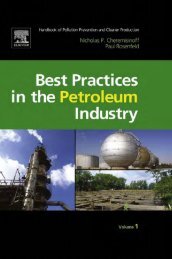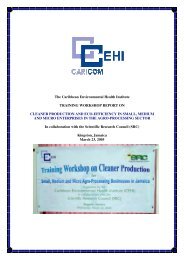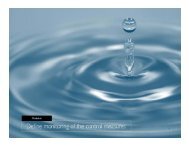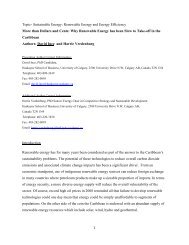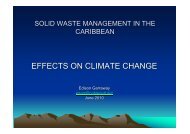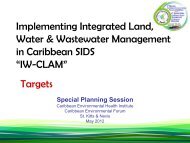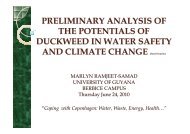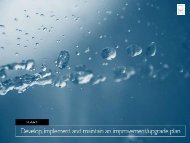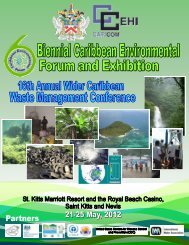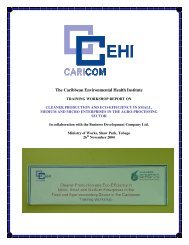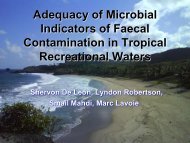A programme for Promoting Rainwater Harvesting in the Caribbean
A programme for Promoting Rainwater Harvesting in the Caribbean
A programme for Promoting Rainwater Harvesting in the Caribbean
You also want an ePaper? Increase the reach of your titles
YUMPU automatically turns print PDFs into web optimized ePapers that Google loves.
<strong>Caribbean</strong> <strong>Ra<strong>in</strong>water</strong> <strong>Harvest<strong>in</strong>g</strong> Programmecharacterized by elevated terra<strong>in</strong>. The geology of <strong>the</strong>se islands is varied and <strong>in</strong>cludesedimentary and volcanics, and freshwater is supplied from surface runoff and groundaquifers. In Jamaica <strong>for</strong> example, a significant area of <strong>the</strong> island is characterized by limestone<strong>for</strong>mations possess<strong>in</strong>g significant ground water reserves. Water scarcity tends to be criticalgenerally <strong>in</strong> areas along <strong>the</strong> coastal fr<strong>in</strong>ge or <strong>in</strong> heavily populated areas where demandexceeds supply capacity.The Lesser Antilles are volcanic islands that <strong>in</strong>clude some of <strong>the</strong> Virg<strong>in</strong> Islands, St. Kitts andMontserrat <strong>in</strong> <strong>the</strong> north southward to Grenada, and <strong>the</strong> corall<strong>in</strong>e islands that <strong>in</strong>clude Antigua,Barbuda and Barbados. The volcanic islands lie at <strong>the</strong> edge of <strong>the</strong> South American Platesubduction zone and are dom<strong>in</strong>ated by elevated terra<strong>in</strong> and orographic lift<strong>in</strong>g yieldsrelatively high moisture regimes. Most of <strong>the</strong> freshwater resources on <strong>the</strong>se islands are derivedfrom surface sources, as ground water tends to be relatively <strong>in</strong>accessible. The corall<strong>in</strong>e islandsare characterized by low elevation and total ra<strong>in</strong>fall accumulations tend to be low result<strong>in</strong>g <strong>in</strong>arid conditions. On <strong>the</strong>se islands water is generally extracted from ground sources andaugmented by ra<strong>in</strong>water harvest<strong>in</strong>g. The Bahamas and <strong>the</strong> Turks and Caicos possess similargeomorphology.The islands <strong>in</strong> <strong>the</strong> <strong>Caribbean</strong> are characterized by a tropical maritime climate. Mean annualra<strong>in</strong>fall <strong>in</strong> <strong>the</strong> Greater Antilles ranges between 1,300 mm and 2,000 mm, althoughaccumulations <strong>in</strong> <strong>the</strong> highest mounta<strong>in</strong> ranges of Jamaica can exceed 5,000 mm. The lowcorall<strong>in</strong>e islands of <strong>the</strong> Lesser Antilles tend to be most arid where mean annual ra<strong>in</strong>fall rangesbetween 1,275 mm and 1,875 mm. In <strong>the</strong> Bahamas ra<strong>in</strong>fall varies over <strong>the</strong> island group,rang<strong>in</strong>g from 600 mm <strong>in</strong> <strong>the</strong> dry south-eastern islands to more than 1,600 mm <strong>in</strong> <strong>the</strong> northwesternislands. The volcanic islands tend to have a higher ra<strong>in</strong>fall regime on account of <strong>the</strong>irelevated terra<strong>in</strong> and consequent orographic ra<strong>in</strong>fall. Mean annual ra<strong>in</strong>fall ranges between1,000 mm and 3,000 mm with higher accumulations <strong>in</strong> <strong>the</strong> <strong>in</strong>terior.Ra<strong>in</strong>fall over <strong>the</strong> region is seasonally distributed with approximately 80% of <strong>the</strong> annual ra<strong>in</strong>falloccurr<strong>in</strong>g between May and December (Enfield & Alfaro, 1999) on account of cyclonic activityassociated with <strong>the</strong> hurricane season. The dry season dur<strong>in</strong>g <strong>the</strong> first half of <strong>the</strong> year ischaracterized by significant moisture stress and <strong>in</strong> many islands water availability isexacerbated by human-<strong>in</strong>duced factors that adversely affect <strong>the</strong> natural environment.Lowered dry-season stream flows and pollution of surface ground water are majormanifestations of unsusta<strong>in</strong>able land use that are now hav<strong>in</strong>g serious implications <strong>for</strong> longtermsocio-economic development. The loom<strong>in</strong>g threat from climate change and <strong>the</strong>possibility <strong>for</strong> altered ra<strong>in</strong>fall patterns warrants concern <strong>for</strong> <strong>the</strong> <strong>Caribbean</strong> whose availablewater resources are already highly vulnerable. In a circumstance of reduced ra<strong>in</strong>fall, this willmean less recharge and more severe water scarcity; <strong>in</strong> a scenario of <strong>in</strong>creased ra<strong>in</strong>fall andmore extreme wea<strong>the</strong>r <strong>the</strong> possibility exists <strong>for</strong> accelerated land and water degradation fromalready degraded watershed areas.3.2. Socio-economic factors and water-related environmentalconsiderationsThe population of <strong>the</strong> <strong>Caribbean</strong> numbers approximately 40.6 million (exclud<strong>in</strong>g Mart<strong>in</strong>iqueand Guadeloupe) (UN-ECLAC, 2004). Of this some 15.8 million are from <strong>Caribbean</strong>Community (CARICOM) member and associate member states. By 2015 <strong>the</strong> population is7



